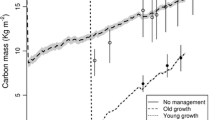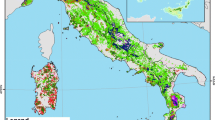Abstract
Using a case study of the Lake Abitibi Model Forest (LAMF), this study aims to assess the temporal and spatial variability in carbon storage during 1990–2000, and to present a comprehensive estimation of the carbon budget for LAMF's ecosystems. As well, it provided the information needed by local forest managers to develop ecological and carbon-based indicators and monitor the sustainability of forest ecosystems. Temporal and spatial carbon dynamics were simulated at the landscape level using ecosystem model TRIPLEX1.0 and Geographical Information System (GIS). The simulated net primary productivity (NPP) and carbon storage in forest biomass and soil were compared with field data and results from other studies for Canada's boreal forests. The results show that simulated NPP ranged from 3.26 to 3.34 tC ha−1 yr−1 in the 1990s and was consistent with the range measured during the Boreal Ecosystem-Atmosphere Studies (BOREAS) in central Canada. Modeled NPP was also compared with the estimation from remote sensing data. The density of total above-and belowground biomass was 125.3, 111.8, and 106.5 tC ha−1 for black spruce, trembling aspen, and jack pine in the LAMF ecosystem, respectively. The total carbon density of forested land was estimated at 154.4 tC ha−1 with the proportion of 4:6 for total biomass and soil. The analysis of net carbon balance of ecosystem suggested that the LAMF forest ecosystem was acting as a carbon sink with an allowable harvest in the 1990s.
Similar content being viewed by others
References
Banfield, G.E., Bhatti, J.S., Jiang, H. and Apps, M.J.: 2002, ‘Variablility in regional scale estimates of carbon stocks in boreal forest ecosystems: Results from West-Central Alberta’, Forest Ecology and Management 169, 15–27.
Bossel, H.: 1996, ‘TREEDYN3 Forest Simulation Model’, Ecological Modelling 90, 187–227.
CCCma: 2003, Canadian Centre for Climate Modelling and Analysis, Environment Canada, Meteorological service of Canada, CGCM2 Data (zip files). Available at http://www. cccma.bc.ec.gc.ca/cgi-bin/data [cited 2 July 2003].
Chen, J.M., Liu, J., Leblanec, S.G., Lacaze, R. and Roujean, J.: 2003, ‘Multi-angular optical remote sensing for assessing vegetation structure and carbon absorption’, Remote Sensing of Environment 84, 516–525.
Chen, J.M., Pavlic, G., Brown, L. and Cihlar, J.: 2002, ‘Derivation and validation of Canada-wide coarse-resolution satellite imagery and ground measurements’, Remote Sensing of Environment 80, 165–184.
CLBRR: 1993, Soil Carbon Data for Canadian Soils, CLBRR Contribution No. 92–179, Centre for Land and Biological Resources Research, Ottawa, Canada.
Cohen, J.: 1960, ‘A Coefficient of agreement for nominal scales’, Educational and Psychological Measurement 20, 37–46.
Dixon, R.K., Brown, S., Houghton, R.A., Solomon, A.M., Trexler, M.C. and Wisniewski, J.: 1994, ‘Carbon pools and flux of global forest ecosystems’, Science 263, 185–189.
Elkie, P.C., Towill, W.D., Ride, K.R. and Mcllwrath, D.L.: 2000, Ontario Land Inventory Primeland/Site Information System (OLIPIS), Ontario Mineral Natural Resources Northwest Science & Technology, Thunder Bay, Ontario, Canada, NWST Technical Manual TM-005.
Emanuel, W.R., Shugart, H.H. and Stevenson, M.P.: 1985, ‘Climate change and the broad-scale distribution of terrestrial ecosystem complexes’, Climate Change 7, 29–43.
Environment Canada: 2000, Narrative Descriptions of Terrestrial Ecozones and Ecoregions of Canada: Boreal Shield Ecozone, Environment Canada, Ottawa, Canada.
Fleming, R.A., Candau, J. and McAlpine, R.S.: 2002, ‘Landscape-scale analysis of interactions between insect defoliation and forest fire in central Canada’, Climatic Change 55, 251–272.
Fluxnet-Canada: 2002, Fluxnet-Canada research network: Influence of climate and disturbance on carbon cycling in forest and pratland ecosystems. Available at http://www.fluxnet-canada.ca/home.php?page=home&setLang=en [cited 5 April 2004].
Foster, N.W. and Morrison, I.K.: 2002, ‘Carbon sequestration by a jack pine stand following urea application’, Forest Ecology Management 169, 45–52.
Gower, S.T., Vogel, J.G., Norman, J.M., Kucharik, C.J., Steele, S.J. and Stow, T.K.: 1997, ‘Carbon distribution and aboveground net primary production in aspen, jack pine, and black spruce stands in Saskatchewan and Manitoba, Canada’, BOREAS special issue, Journal of Geophysical Research 102(24D), 29029–29041.
Griffin, T.: 2001, Lake Abitibi Model Forest Local Level Indicator Status Report: 2000, Lake Abitibi Model Forest, Ontario, Canada.
Halliwell, D.H. and Apps, M.J.: 1997a, Boreal Ecosystem-Atmosphere Study (BOREAS) Biometry and Auxiliary Sites: Overstory and Understory Data, Northern Forestry Centre, Edmonton, Canada.
Halliwell, D.H. and Apps, M.J.: 1997b, Boreal Ecosystem-Atmosphere Study (BOREAS) Biometry and Auxiliary Sites: Soils and Detritus Data, Northern Forestry Centre, Edmonton, Canada.
Halliwell, D.H., Apps, M.J. and Rice, D.T.: 1995, ‘A survey of the forest site characteristics in a transect through the central Canadian boreal forest’, Water Air and Soil Pollution 82, 275–270.
Kimball, J.S., Keyser, A.R., Running, S.W. and Saatchi, S.S.: 2000, ‘Regional assessment of boreal forest productivity using an ecological process model and remote sensing parameter maps’, Tree Physiology 20, 761–775.
Kimball, J.S., Thornton, P.E., White, M.A. and Running, S.W.: 1997, ‘Simulating forest productivity and surface-atmosphere carbon exchange in the BOREAS study region’, Tree Physiology 17, 589–599.
Kurz, W.A., Apps, M.J., Comeau, P.G. and Trofymow, J.A.: 1996a, The Carbon Budget of British Colombia's Forests, 1920–1989: Preliminary Analysis and Recommendations for Refinements, Canada, FRDA Report No. 261, pp. 1–62.
Kurz, W.A., Apps, M.J., Webb, T.M. and McNamee, P.J.: 1992, The Carbon Budget of the Canadian Forest Sector: Phase 1, Northern Forestry Centre, Edmonton, Canada, Forestry Canada Information Report, NOR-X-326.
Kurz, W.A., Beukema, S.J. and Apps, M.J.: 1996b, ‘Estimation of root biomass and dynamics for the carbon budget model of the Canadian forest sector’, Canadian Journal of Forest Research 26, 1973–1979.
Lai, R., Kimble, J.M., Follett, R.F. and Stewart, B.A.: 1997, Soil Processes and the Carbon Cycle, Chap. 7, Boca Raton, FL, CRC Press, pp. 93–101.
Landsberg, J.J. and Waring, R.H.: 1997, ‘A generalized model of forest productivity using simplified concepts of radiation-use efficiency, carbon balance and partitioning’, Ecological Modelling 95, 209–228.
Liu, J., Chen, J.M., Cihlar, J. and Park, W.M.: 1997, ‘A process-Based based Ecosystem ecosystem productivity simulator using remote sensing inputs’, Remote Sensing of Environment 62, 158–175.
Liu, J., Chen, J.M., Cihlar, J. and Chen, W.: 2002a, ‘Net primary productivity mapped for Canada at 1 km resolution’, Global Ecology and Biogeography 11, 115–129.
Liu, J., Peng, C., Apps, M.J., Dang, Q., Banfield, E. and Kurz, W.: 2002b, ‘Historic carbon budgets of Ontario's forest ecosystems’, Forest Ecology Management 169, 103–114.
Liu, J., Peng, C., Dang, Q., Apps, M.J. and Jiang, H.: 2002c, ‘A component Objective Model Strategy for Reusing Ecosystem Models’, Computers and Electronics in Agriculture 35, 17–33.
Monserud, R.A.: 1990, Methods for Comparing Global Vegetation Maps, Working Paper WP-90-40, International Institute of Applied Systems Analysis, Laxenburg, Austria, pp. 5–21.
Nalder, I.A. and Merriam, H.G.: 1995, ‘Simulating carbon dynamics of the boreal forest in Pukaskwa National Park’, Water Air and Soil Pollution 82, 283–298.
Neilson, R.P. and Marks, D.: 1994, ‘A global perspective of regional vegetation and hydrologic sensitivities from climatic change’, Journal of Vegetation Science 5, 715–730.
Newcomer, J., Landis, D., Conrad, S., Curd, S., Huemmrich, K., Knapp, D., Morrell, A., Nickeson, J., Papagno, A., Rinker, D., Strub, R., Twine, T., Hall, F. and Sellers, P.: 2000, Collected Data of the Boreal Ecosystem-Atmosphere Study, CD-ROM, TE-06, The BOREAS Information System NASA Goddard Space Flight Centre, USA.
Oelschlagel, B.: 1995, ‘A method for downscaling global climate model calculation by a statistical weather generator’, Ecological Modelling 82, 199–204.
ORNL: 2002, Global Soil Data Products, Oak Ridge National Laboratory, Oak Ridge, TN.
Parton, W.J., Schimel, D.S., Cole, C.V. and Ojima, D.S.: 1987, ‘Analysis of factors controlling soil organic matter levels in Great Plains grasslands’, Soil Science Society of America Journal 51, 1173–1179.
Parton, W.J., Scurlock, J.M., Ojima, D.S., Gilmanov, T.G., Scholes, R.J., Schimel, D.S., Kirchner, T., Menaut, J-C., Seastedt, T., Garcia Moya, E., Apinan, K. and Kinyamario, J.I.: 1993, ‘Observations and modelling of biomass and soil organic matter dynamics for the grassland biome worldwide’, Global Biogeochemical Cycles 7(4), 785–809.
Pastor, J. and Post, W.M.: 1988, ‘Response of northern forests to CO2-induced climate change’, Nature 334, 55–58.
Peng, C. and Apps, M.J.: 1999, ‘Modelling the response of net primary productivity (NPP) of boreal forest ecosystems to changes in climate and fire disturbance regimes’, Ecological Modelling 122, 175–193.
Peng, C., Apps, M.J. and Price, D.T.: 1998, ‘Simulating carbon dynamics along the Boreal Forest Transect Case Study (BFTCS) in central Canada, 1. Model testing’, Global Biogeochemical Cycles 12, 381–402.
Peng, C., Liu, J., Apps, M., Dang, Q. and Kurz, W.: 2000, Quantifying Ontario's Forest Carbon Budget (1. Carbon Stocks and Fluxes of Forest Ecosystems in 1990), Forest Research Report No. 158, Ontario Forest Research Institute, Canada.
Peng, C., Liu, J., Dang, Q., Apps, M.J. and Jiang, H.: 2002, ‘TRIPLEX: A generic hybrid model for predicting forest growth and carbon and nitrogen dynamics’, Ecological Modelling 153, 109–130.
Penner, M., Power, K., Muhairwe, C., Tellier, R. and Wang, Y.: 1997, Canada's Forest Biomass Resources: Deriving Estimates from Canada's Forest Inventory, Information report BC-X-370, Pacific Forestry Centre, Victoria, Canada.
Prentice, I.C., Cramer, W., Harrison, S.P., Leemans, R., Monserud, R.A. and Solomon, A.M.: 1992, ‘A global biome model based on plant physiology and dominance, soil properties and climate’, Journal of Biogeography 19, 117–134.
Price, D.T., Halliwell, D.H., Apps, M.J., Kurz, W.A. and Curry, S.R.: 1997, ‘Comprehensive assessment of carbon stocks and fluxes in a Boreal-Cordilleran forest management unit’, Canadian Journal of Forest Research 27, 2005–2016.
Price, D.T., Peng, C., Apps, M.J. and Halliwell, D.H.: 1999, ‘Simulating effects of climate change on boreal ecosystem carbon pools in central Canada’, Journal of Biogeography 26, 1237–1248.
Ryan, M.G., Lavigne, M.B. and Gower, S.T.: 1997, ‘Annual carbon cost of autotrophic respiration in boreal forest ecosystems in relation to species and climate’, BOREAS special issue, Journal of Geophisical Research 102(D24), 28871–28883.
Siltanen, R.M., Apps, M.J., Zoltai, S.C., Mair, R.M. and Strong, W.L.: 1997, A Soil Profile and Organic Carbon Data Base for Canadian Forest and Tundra Mineral Soils, Northern Forestry Centre, Canadian Forest Service, Edmonton, Canada.
Steele, S.J., Gower, S., Vogel, J.G. and Norman, J.M.: 1997, ‘Root mass, net primary production and turnover in aspen, jack pine and black spruce forests in Saskatchewan and Manitoba, Canada’, Tree Physiology 17, 577–587.
Tremblay, S., Ouimet, R. and Houle, D.: 2002, ‘Prediction of organic carbon content in upland forest soils of Quebec, Canada’, Canadian Journal of Forest Research 32, 903–914.
Zhou, X., Peng, C. and Dang, Q.: 2004, ‘Assessing the generality and accuracy of the TRIPLEX model using in situ data of Boreal Forests in Central Canada’, Environmental Modelling and Software 19, 35–46.
Author information
Authors and Affiliations
Corresponding author
Rights and permissions
About this article
Cite this article
Zhou, X., Peng, C., Dang, QL. et al. A Simulation of Temporal and Spatial Variations in Carbon at Landscape Level: A Case Study for Lake Abitibi Model Forest in Ontario, Canada. Mitig Adapt Strat Glob Change 12, 525–543 (2007). https://doi.org/10.1007/s11027-006-4583-5
Received:
Accepted:
Published:
Issue Date:
DOI: https://doi.org/10.1007/s11027-006-4583-5




